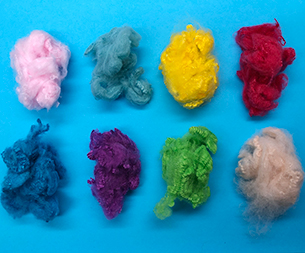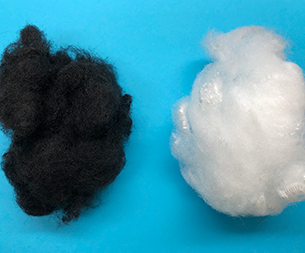Where did your old clothes go? Did you throw them away at random or sent them to the clothing recycling bin? According to the China National Textile and Apparel Council's calculations, if all the waste textiles in our country can be recycled, it can save 24 million tons of crude oil a year. , Save nearly 1/3 of the cotton planting area and reduce 80 million tons of carbon dioxide emissions.
The Chinese Academy of Engineering’s consulting and research project "Research on the Development Strategy of Waste Chemical Fiber Textile Resources Recycling Technology" was held recently in Beijing. The research report puts forward China’s report on the basis of in-depth combing and comparison of the status and development trends of waste chemical fiber textile resources at home and abroad. The key tasks of recycling of waste chemical fiber textile resources have clarified the development direction of the entire industry chain technology system.
my country is the world's largest chemical fiber production and application country. In 2016, the total output of chemical fiber reached 49.44 million tons, accounting for 69.4% of the total global fiber. The total processing volume of textile fiber was 54.2 million tons, of which chemical fiber accounted for 84.23%, occupying a leading position. With the rapid development of the industry and the surge in consumption, the disposal of waste chemical fiber textiles also follows. It is estimated that by the end of the "13th Five-Year Plan" period, my country's waste chemical fiber textile production will reach nearly 200 million tons, but my country's textile recycling rate is less than 10%, which is a significant gap compared with developed countries.
Waste chemical fiber textiles are treated as garbage for simple disposal such as landfill or incineration, which not only seriously pollutes the environment, but also causes a great waste of resources. Seeking regeneration and recycling has become an urgent need for the development of my country's textile industry.
According to Jiang Shicheng, an academician of the Chinese Academy of Engineering, in order to promote the sound development and comprehensive upgrading of China's chemical fiber recycling industry, the Chinese Academy of Engineering established a consulting project "Research on the Development Strategy of Waste Chemical Fiber Textile Resource Recycling Technology" in 2017, led by an academician in the textile field, relying on Donghua Universities, and invited more than 40 people including experts from relevant universities and institutes and representative enterprises to participate in the research. It took more than a year to form a research report and academician recommendations.
"The recycling of chemical fiber is an important direction in the new era of the chemical fiber industry." Project Secretary-General Wang Huaping said that in the next 10 years, we must be guided by "zero abandonment, clean, low-carbon, high-efficiency, high-quality, and high-value" and take major technological projects as the starting point. , Supported by the construction of an independent innovation system combining “politics, production, learning, research, and application”, a national-level textile recycling research and engineering technology development platform has been established to enable China’s polyester, polyamide, polypropylene, and polyphenylene sulfide The recycling technology and innovation capabilities of other key chemical fiber varieties rank among the top in the world.
On this basis, the project proposed key tasks. The first is the research on the basic scientific issues of the regeneration of waste chemical fiber materials; the second is the rapid identification and sorting technology of waste chemical fiber textiles; the third is the pretreatment and resource standardization of waste chemical fiber textiles; the fourth is the key technology of mechanical and physical regeneration and the industrialization upgrade; 5. It is the key technology and industrialization of physical and chemical regeneration; the sixth is the key technology and industrialization of chemical regeneration.
At the same time, the project formed 3 special proposals. First, build a modern recycling and logistics system for waste textiles. Under the coordination of relevant national departments, unite local governments and professional structures to establish a waste textile logistics technology and equipment procurement list, and form a complete system, complete function, and orderly management and operation of waste chemical fiber textile recycling logistics industry chain in the form of government special subsidies. Relying on the construction of a modern recycling logistics information platform, we will advance the construction of intelligent recycling boxes, professional logistics vehicles, and distribution management stations in an orderly manner to build a 200-kilometer recycling economic circle and achieve full coverage of the recycling logistics network system.
Second, construction of waste chemical fiber textile recycling industry cluster and demonstration park. Make full use of synergy and scale effects, optimize resource allocation, improve resource utilization efficiency, form a radiant drive in a point-to-surface, point-to-surface combination, and promote the rapid realization of the recycling industry of waste chemical fiber textiles.
Third, build a platform for innovation and display of waste chemical fiber textile production, study, research and use. It is recommended that the state set up a special state key laboratory for promoting the recycling of waste textiles and a national engineering technology research center, strengthen the construction of scientific research and talent platforms, and accelerate the in-depth basic research on chemical fiber regeneration and the transformation of research results.
- How does Keqiao take new quality
- In what aspects is the superior
- Can the textile terminal "burst
- Learn about the production proce
- Xinjiang cotton has become an im
- What are the precautions for sto
- China's cotton industry poses a
- Polypropylene staple fiber good
- Supply and demand expectations a
- Polypropylene staple fiber is wi
- Markets
- Automotive Products
- Nonwoven Lining
- Geosynthetics
- Liquid Filtration
- Apparel and Textiles
- Hygiene Products
- Building and Construction
- Other Markets
- Contact Us
- Contact Haibang





